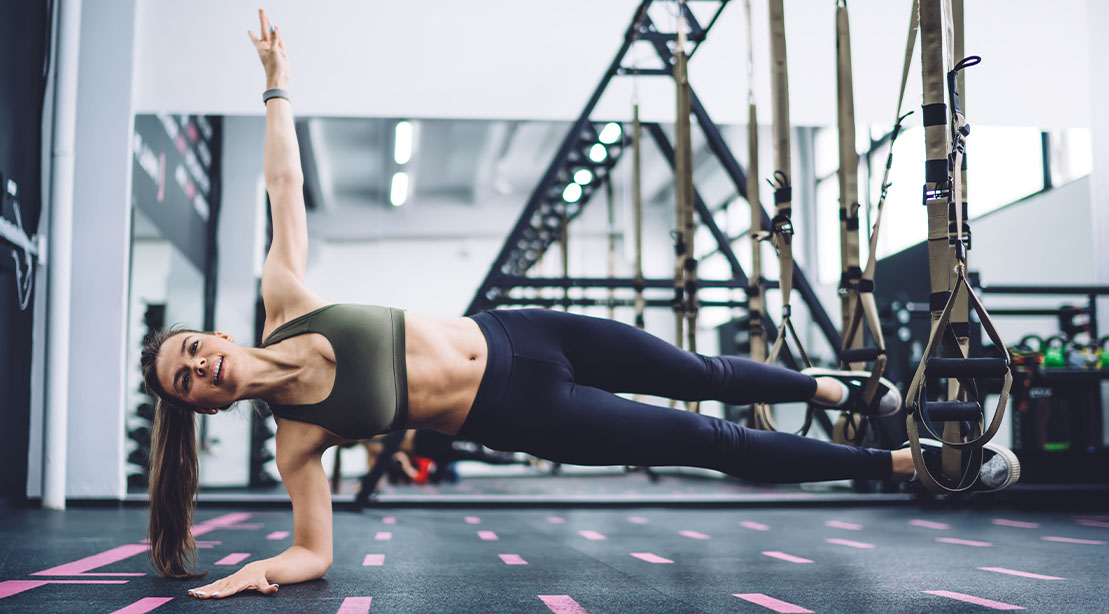28-Days-to-Lean Meal Plan
With the right plan and the right discipline, you can get seriously shredded in just 28 days.
Read article
Your inner thighs and obliques need some love, too. And yes, this was written with a straight face. It’s time to give those adductors and love handles some much-needed attention with the challenging Copenhagen Side Plank with Knee Tuck. This exercise isn’t just about a chiseled core—it’s about building strength where needed and reducing injury risk.
Imagine strengthening your obliques and shoulders while training the often-overlooked muscles of your inner thighs. That’s the magic of the Copenhagen Side Plank with Knee Tuck. This exercise boosts your core stability and targets your adductors, improving your lower body’s strength and coordination.
Here, we will delve into the Copenhagen side plank with knee tuck. We’ve got you covered, from perfecting your form to understanding its benefits. So, you’ll be ready to take your core and adductor strength to a new level.
The Copenhagen side plank is a progression of the traditional side plank that increases the intensity by training the adductors. Named after the city where research was conducted on its benefits, it’s fantastic for building core and lower body strength. Elevating your top leg onto a bench or similar surface, your adductors kick in to keep your hips elevated and your body straight. This is hard enough, but hang on to your gym shorts because it will get more challenging.
Ready to take your side plank game to the next level? Here’s how to perform the Copenhagen side plank with knee tuck:
Copenhagen Side planks and their variations are not fun but have tremendous benefits.
This exercise is challenging, particularly for your lower abs. By keeping your hips elevated and performing the knee tuck, you improve the strength and stability of your entire core. This strength is crucial for aesthetics and improving performance in other exercises and daily activities.
The Copenhagen Side Plank with Knee Tuck targets the adductor muscles because your inner thighs are the only thing stopping you from crushing to the ground. Strong adductors are essential for various athletic movements such as running, jumping, and changing directions quickly. Strengthening these muscles can help prevent injuries, particularly in sports that involve lateral movements.
Incorporating the knee tuck adds a dynamic element that challenges balance and coordination. The knee tuck requires control and stabilization, helping to improve balance and coordination by preventing the hips from meeting the floor.
It’s a tough exercise, which means things can go wrong when you’re hanging on for dear life. Here’s how to get the best out of this tough exercise
Letting your hips sag or rotate forward means the benefits discussed above go bye-bye and can increase the risk of lower back ouchy.
Fix: Stiffen your core and glutes to keep your body straight from head to feet. Visualize a straight line running through your body and work to maintain this throughout the exercise.
Arching your lower back due to a lack of core stiffness can lead to discomfort and potential injury.
Fix: Focus on keeping your core tight and your spine neutral. Brace your abs like you are about to take a punch to your stomach.
Holding your breath can cause unnecessary fatigue, making the exercise harder than it needs to be.
Fix: Maintain steady breathing, focusing on breathing into your obliques. Exhale as you bring your knee towards your chest, and inhale as you extend your leg back.
If you are game, do the Copenhagen Side Plank with Knee Tuck twice weekly to reap the benefits. Start with 2-3 sets of 10-15 knee tucks per side. As you become stronger, increase the reps to challenge you further.